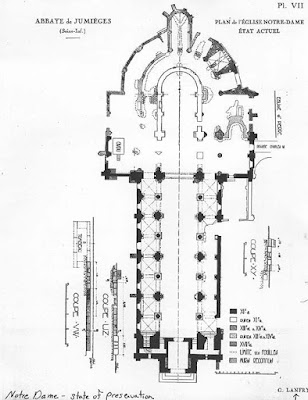The Romanesque period was a period marked by immense relief , as the world was stunned as it hadn’t ended at the turn of the millennium (999/1000 AD). After this, a chain of events that would impact the rest of the world would follow: The resurgence of cities and trade, strengthened Papal authority, the emergence of a middle/ merchant class, the peak in feudalism as a political system. Moreover, there was continued growth in monasticism with two prominent orders:
Cistercian ‐ manual labor and self denial, and most importantly Cluniac ‐ education, music and art.
 Located on the bends of the Seine downstream of Rouen, between London and Paris, the abbey was founded in 654 by Saint Philibert, a courtier at the court of king Dagobert 1st, and eventually went on to be one of the most important and ancient monasteries in the western world. The abbey has a very unique feature which consists of two churches of which the most ancient (Saint-Pierre) shows how the walls of it were destroyed by the Vikings and restored in 942. Destroyed in 841 by the Vikings and again during the Hundred Years War, it was used as a source of dressed stone after the French Revolution.
Located on the bends of the Seine downstream of Rouen, between London and Paris, the abbey was founded in 654 by Saint Philibert, a courtier at the court of king Dagobert 1st, and eventually went on to be one of the most important and ancient monasteries in the western world. The abbey has a very unique feature which consists of two churches of which the most ancient (Saint-Pierre) shows how the walls of it were destroyed by the Vikings and restored in 942. Destroyed in 841 by the Vikings and again during the Hundred Years War, it was used as a source of dressed stone after the French Revolution.
The layout for this 11th century church was based on Carolingian and Ottonian prototypes and dates to the last years of Abbot Thierry and William of Dijon, which were from about 1025–30. However, the work continued under Abbots Robert II of Champart, who became archbishop of Canterbury and Robert III, abbot from 1059 to 1078.
Notre Dame is a three-aisled plan consisting of four square bays in the nave, a projecting transept, a vaulted entrance block and a projecting porch with a single portal, flanked by towers aligned with the nave aisles; the crossing is square and is marked by large compound piers.
The structure of the main church has a staple feature which are the naves.“The nave, meaning “ship,” symbolized a contained vessel, ferrying souls from damnation to redemption. The naves are strategically placed in a way so that the light off of the east wall carries through them to make light present not only on the outer banks of the sanctuary but also in its center.
In 1098 AD the abbey at Citeaux was founded, which later lead to the start of the church at Fontenay. The abbey at Citeaux is no longer standing, but the church at Fontenay is a representation of the monks approach to architecture. The arches that were placed in the interior of the main church, not only have an architectural purpose, but also a spiritual representation.
The buildings and cloister were on the south side of the nave; the chapter house, a large double-bay structure with an eastern hemicycle, go back to the first quarter of the 12th century. Archaeology informs us that most of the early abbots of Jumièges were buried here.
Apart from other buildings, other important construction included the westwerk, main nave and aisles, original Romanesque chevet with ambulatory and galleried transepts, which contain the earliest example of double-wall construction.
Sources:
- Conant, Kenneth John. Carolingian and Romanesque Architecture 800 to 1200. Harmondsworth: Penguin, 1959. Print.
- Wilkes, Joseph A. Encyclopedia of Architecture: Design, Engineering & Construction. New York U.a.: Wiley, 1989. Print.
-"Building History | Jumieges, Abbey Church of Notre-Dame | Briefing | Professor Lynn Courtenay | Medieval Architecture." Building History | Jumieges, Abbey Church of Notre-Dame | Briefing | Professor Lynn Courtenay | Medieval Architecture. N.p., n.d. Web. 04 Dec. 2016."


No comments:
Post a Comment